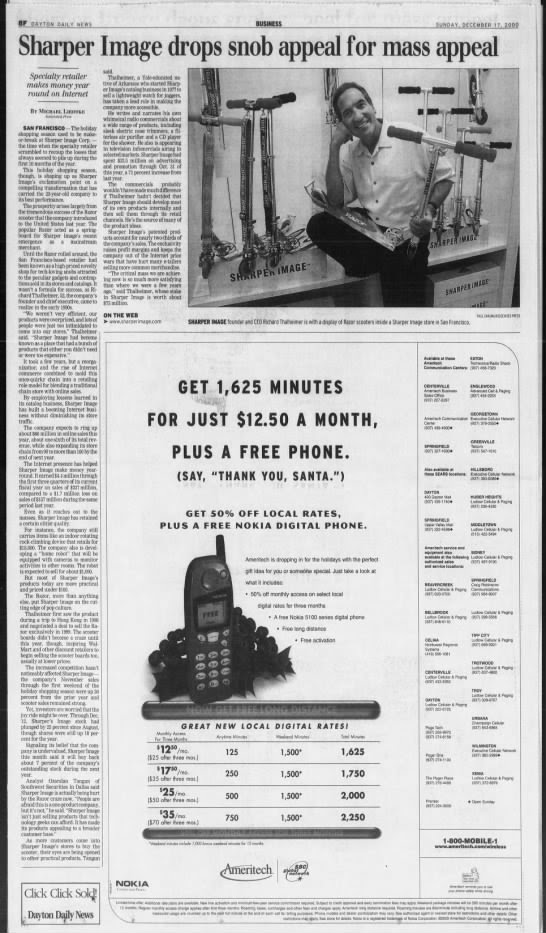The holiday shopping season used to be make-or-break at Sharper Image Corp. – the time when the specialty retailer scrambled to recoup the losses that always seemed to pile up during the first 10 months of the year.
This holiday shopping season, though, is shaping up as Sharper Image’s exclamation point on a compelling transformation that has carried the 23-year-old company to its best performance.
The prosperity arises largely from the tremendous success of the Razor scooter that the company introduced to the United States last year. The popular Razor acted as a springboard for Sharper Image’s recent emergence as a mainstream merchant.
Until the Razor rolled around, the San Francisco-based retailer had been known as a high-priced novelty shop for tech-loving snobs attracted to the peculiar gadgets and contraptions sold in its stores and catalogs. It wasn’t a formula for success, as Richard Thalheimer, 52, the company’s founder and chief executive, came to realize in the early 1990s.
“We weren’t very efficient, our products were overpriced, and lots of people were just too intimidated to come into our stores,” Thalheimer said. “Sharper Image had become known as a place that had a bunch of products that either you didn’t need or were too expensive.”
It took a few years, but a reorganization and the rise of Internet commerce combined to mold this once-quirky chain into a retailing role model for blending a traditional chain store with online sales.
By employing lessons learned in its catalog business, Sharper Image has built a booming Internet business without diminishing its store traffic.
The company expects to ring up about $60 million in online sales this year, about one-sixth of its total revenue, while also expanding its store chain from 90 to more than 100 by the end of next year.
The Internet presence has helped Sharper Image make money year-round. It earned $4.4 million through the first three quarters of its current fiscal year on sales of $237 million, compared to a $1.7 million loss on sales of $157 million during the same period last year.
Even as it reaches out to the masses, Sharper Image has retained a certain elitist quality. For instance, the company still carries items like an indoor rotating rock-climbing device that retails for $15,000. The company also is developing a “home robot” that will be equipped with cameras to monitor activities in other rooms. The robot is expected to sell for about $1,000.
But most of Sharper Image’s products today are more practical and priced under $100.
The Razor, more than anything else, put Sharper Image on the cutting edge of pop culture.
Thalheimer first saw the product during a trip to Hong Kong in 1998 and negotiated a deal to sell the Razor exclusively in 1999. The scooter boards didn’t become a craze until this year, though, inspiring Wal-Mart and other discount retailers to begin selling the scooter boards too, usually at lower prices.
The increased competition hasn’t noticeably affected Sharper Image – the company’s November sales through the first weekend of the holiday shopping season were up 30 percent from the prior year and scooter sales remained strong.
Yet, investors are worried that the joy ride might be over. Through Dec. 12, Sharper’s Image stock had plunged by 25 percent since August, though shares were still up 18 percent for the year.
Signaling its belief that the company is undervalued, Sharper Image this month said it will buy back about 7 percent of the company’s outstanding stock during the next year.
Analyst Ozarslan Tangun of Southwest Securities in Dallas said Sharper Image is actually being hurt by the Razor craze now. “People are afraid this is a one-product company, but it’s not,” he said. “Sharper Image isn’t just selling products that technology geeks can afford. It has made its products appealing to a broader customer base.”
As more customers come into Sharper Image’s stores to buy the scooter, their eyes are being opened to other practical products, Tangun said.
Thalheimer, a Yale-educated native of Arkansas who started Sharper Image’s catalog business in 1977 to sell a lightweight watch for joggers, has taken a lead role in making the company more accessible.
He writes and narrates his own whimsical radio commercials about a wide range of products, including sleek electric nose trimmers, a filterless air purifier and a CD player for the shower. He also is appearing in television infomercials airing in selected markets. Sharper Image had spent $32.5 million on advertising and promotion through Oct. 31 of this year, a 71 percent increase from last year.
The commercials probably wouldn’t have made much difference if Thalheimer hadn’t decided that Sharper Image should develop most of its own products internally and then sell them through its retail channels. He’s the source of many of the product ideas.
Sharper Image’s patented products account for nearly two-thirds of the company’s sales. The exclusivity raises profit margins and keeps the company out of the Internet price wars that have hurt many e-tailers selling more common merchandise.
“The critical mass we are achieving now is so much more satisfying. then where we were a few years ago,” said Thalheimer, whose stake in Sharper Image is worth about’ $75 million.




